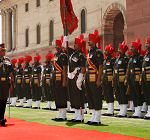The Ministry of Defence and the Prime Minister’s Office (PMO) have authorised the formation of a mountain strike corps of 100,000 troops. This massive military formation would include independent artillery, armoured and infantry brigades, and a wide range of specialised equipment. India will spend approximately Rs. 64,000 crores on this and other military enhancements. The strike corps, which could be used for offensive operations against China, is our biggest military accretion for possible use against China since 1962.
The eventual emergence of this corps will be another manifestation of India’s inordinate preoccupation with China. The absolute defeat of the Indian military by the Chinese during the 1962 conflict deeply affected many from an entire generation of Indians; half a century later, that debacle continues to impact our policies and bilateral behaviour. India has engaged in three wars and numerous conflicts with Pakistan, but it is the spectre of China that continues to be an obsession for India.
The relations between the two neighbours remain tenuous, riddled with contentious border and territorial issues. India is also trying to mirror or compete with China’s military build-up in Tibet. The expectation that China’s GDP is likely to decline while India’s GDP is expected to grow, further fuels the mutual insecurity and competitiveness.
The proposed mountain strike corps is a continuation of this historical context of suspicion and distrust. But such a huge expenditure on defence in these economically challenging times is unreasonable, and evokes parallels with the Cold War. During the Cold War, a frenetic arms race between the U.S. and the Soviet Union resulted in Moscow building up a military that consumed as much as 25% of the U.S.S.R.’s gross national product. Funding for the military detracted investment in civilian sectors and caused the U.S.S.R. to go into an economic tailspin from which it has never recovered – and which ultimately led to its dismemberment. Although India is nowhere near such a situation, it is useful to remember the lessons of an obsessive arms race.
The U.S. and India have recently engaged in wide-ranging military interaction in the form of joint exercises and an increase in the supply of arms to India. This activity possibly fuels the Chinese fear that India is part of the U.S. plan to encircle China with Asian countries aligned to the US. Such a perception may encourage China to adopt a strategy of neutralisation to try to check or retard India on multiple fronts—not only military, but on diplomatic and economic terrain as well. One way that China could do this is by developing closer relations with our neighbours to form a pro-China bloc in the sub-continent.
In fact, China’s economic and military engagement with its neighbours in Asia has already been more effective than India’s neighbourhood overtures. This may be part of a Chinese counter-plan to encircle India and to stoke Indian fears. Our national defence directive to the armed forces requires them to be ready for a war on two-and-a-half-fronts —with China supported by Pakistan or the reverse, and an internal insurgency supporting the two aggressors. The military capability required to achieve this could result in crippling costs to us—and that may be just what China wants.
An absence of a coherent, stated national policy on potential threats and strategies to deal with them, adds to the India’s confusion on how to perceive China. The raising of the strike corps is a case in point. In late 2011-early 2012, the plan was approved in principle and later fast-tracked by the PMO; this was done after the army conveyed intelligence reports to the Prime Minister indicating that China had been rehearsing a limited offensive during military exercises. The Defence Ministry then sent the plan to the Ministry of Finance for scrutiny before it could be placed for approval by the Cabinet Committee for Security. The Ministry of Finance returned the plan with detailed questions.
Some officials believe the finance ministry’s circumspect position on the matter comes from its unwillingness to clear such a high-cost defence plan in this financial year. This and other similar episodes clearly indicate that India needs to develop a realistic national threat perception policy according to which the armed forces can then prepare and train. Constantly working on worst case scenarios can be very expensive, if not economically crippling.
China can easily decelerate India economically, by pushing us to spend more on defence; this can be achieved by whipping up a perception of threat—exaggerate border tensions and skirmishes, make territorial claims, blame India for the Tibet problem and raise other irritants. The resultant fear successfully fuels our already well-developed preoccupation with China and sends us scurrying to find military solutions to what is essentially a diplomatic problem.
This does not mean there is no need for the armed forces to be prepared for any possible threat from China. However, the threat cannot be countered with reactive measures; it must be realistically assessed and prepared for in consonance with a long-term plan. Our relations with China in the long-term would be better served by avoiding an arms race, staying away from the rivalry between the U.S and China, and fostering stronger relations with all our immediate neighbours.
Xerxes Adrianwalla is a retired Brigadier of the Indian Army and a regular contributor to Gateway House: Indian Council on Global Relations.
This article was exclusively written for Gateway House: Indian Council on Global Relations. You can read more exclusive content here.
For interview requests with the author, or for permission to republish, please contact outreach@gatewayhouse.in.
© Copyright 2012 Gateway House: Indian Council on Global Relations. All rights reserved. Any unauthorized copying or reproduction is strictly prohibited.


